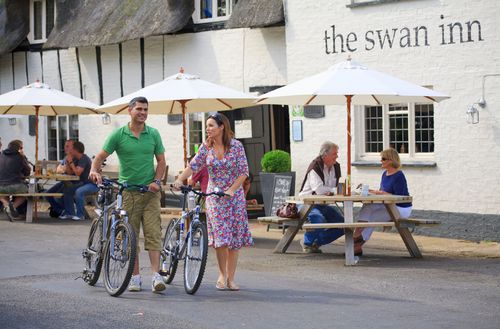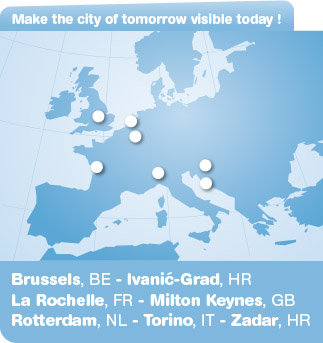Milton Keynes, United Kingdom
Milton Keynes (230,000 inhabitants) is a new town designed
to be a regional hub between Birmingham and London and Oxford and
Cambridge. It is one of the few British cities that was built 50 years
ago with future growth in mind. Today, it is one of the fastest growing
cities in the UK with an estimated population growth reaching more than
300,000 inhabitants by 2025 and 500,000 by 2050.

© Destination Milton Keynes
The challenge of implementing Living Streets in a new town
In MK the individual car is the main mode of transport, facilitated
by a grid system similar to Los Angeles. Milton Keynes has few traffic
lights and many roundabouts which makes driving around the city easy and
the promotion of sustainable mobility more difficult.
However, there are 250 km of cycle and walking routes in MK, called
“redways” that are completely independent from car traffic. MK has also
many green spaces and sidewalks for pedestrians.
So, the challenge Living Streets faced here is to solve something
that is not yet a problem as currently there is no traffic congestion,
people are able to drive around the city easily and plenty of parking
space is available. Nevertheless, by 2025 it is estimated that there
will be a travel demand increase of 60% while practical capacity
improvements will only address a 25% increase.
"Community engagement establishes understanding between neighbours
and promotes inclusivity. The Living Streets project is a great idea
that fulfils this role and contributes to the positive vision we have
for Milton Keynes in 2050 and beyond." (Councillor Peter Marland, Leader of Milton Keynes Council)
Reaching out to local councillors, civil servants, stakeholders and citizens
Living streets encouraged departments in the Council working together
that do not habitually collaborate such as the energy and culture
departments.
For Living Streets, MK residents were approached in different
neighbourhoods throughout the city. Enthusiasm for the project was shown
on several occasions however each neighbourhood eventually declined
this opportunity for several different reasons: lack of time, opposition
of a few inhabitants who didn’t feel comfortable with the idea of
Living Streets or the budget offered for implementing Living Streets was
not appealing enough, particularly compared to the budget residents
usually receive for initiatives such as creating a community orchard. In
this car-centric city there is a real anxiety for most citizens about
walking and riding a bicycle and residents are reluctant to make
something unpopular happen in their neighbourhood. Having to think
differently and give up parking their individual cars in front of their
houses was difficult for most streets. Citizens seem to be happy with
the quality of life they have in this 50-year-old city where they do not
face traffic jams. Most citizens have no problems with finding parking
spaces at home, leisure activities and at their place of work while
still being able to enjoy green areas on their doorstep.
"Looking forward to the project and no cars. I’d welcome more buses,
especially running along Watling Street all the way to Bletchley." (A Milton Keynes citizen)
"I wish it would create parking spaces though, rather than lose them!" (A Milton Keynes citizen)
The conclusion is that people need to be encouraged to be involved in
their street projects by starting small and taking baby steps. Focusing
on their fears and worries, such as time spent commuting in their cars,
would be a good starting point for Living Streets in the future.
Gaining trust and support is a very slow process and initially the
support offered by the MK Council was perceived as top down but it did
improve over time.
"What a lovely idea. I’ve often hoped that the top end of the High
Street would be pedestrianised. This would make a huge difference to the
Town." (A Milton Keynes citizen)
The MK coordinator met with several not for profit organisations to
discuss working together to make Living Streets happen in their area.
This brought together like minded people and was a good way to reach
active citizens in the MK communities. Meetings were arranged with local
clubs, associations, residents’ associations and charities and mutual
goals were realised. One collaboration resulted in meeting families at
two events organised with the Milton Keynes Play Association and MK
Council will continue to work with this organisation in the future.
"We are acting as catalysts with local communities, encouraging
people to have a say in how their street and quality of life could be
improved. This is important because there is a general view that the
council makes decisions from the top down." (Christine Ballard, Neil Sainsbury, Shane Downer, civil servants at MK Council)
"The Living Streets project provided a great way to meet citizens and
learn more about what is important to their communities from those who
live there. The work invested in this project has built relationships
with citizens and broken down barriers in communication. This ground
work will continue to reap benefits in future community projects." (Neil Allen, Head of Regulatory Services, Milton Keynes Council)
Living Streets is planting a seed for the future
It is well known that personal transport is difficult to replace in
the UK and particularly in Milton Keynes because it was designed for
cars. However, some communities were willing to accept this restriction.
Thames Valley police are interested in collaborating in Living Streets
mainly because neighbours talking to each other means problems can be
discussed. Furthermore, Town and Parish Councils are also familiar with
Living Streets and are willing to proceed to some traffic restriction.
"It was amazing to witness first-hand how the Living Streets
Programme proved that streets can play such a fundamental role as an
extension to private gardens and provide a place for residents to
socially interact.
When we visited Ghent, it was evident that streets can be the glue that knits residents together." (Neil Sainsbury, Head of Urban Design and Landscape Architecture)
Living Streets have also had a positive influence on future planning
strategies in a growing city where new neighbourhoods will be developed
based on a more people-centric approach. This is the fruit of strategic
municipal departments being involved in Living Streets and of the
widespread understanding within MK Council of this initiative.
So, in Milton Keynes, the Living Streets initiative has planted seeds
and supporters of the idea are waiting for conditions to become more
fertile so results become real and visible.
Contact
Christine Ballard, Project Manager, Sustainability Team, Milton Keynes Council







